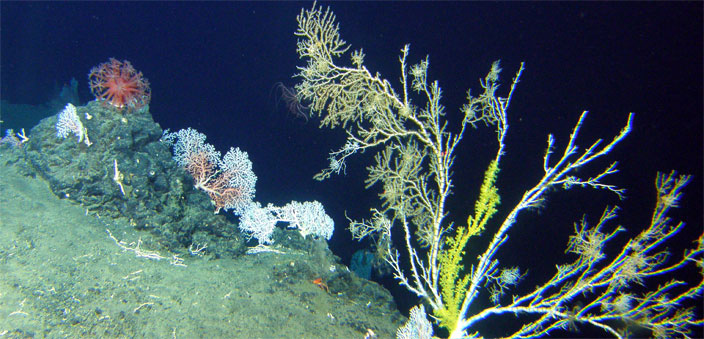Biomolecules are the compounds which form the basis of life: they build up the living system and are responsible for their survival and sustenance. Biomolecules are large molecules of many sub-units bonded together. These could be divided broadly into four categories, viz., carbohydrates, proteins, lipids and nucleic acids. Carbohydrates are made up of sugars, proteins of amino acids, lipids of fatty acids, and nucleic acids of nucleotides. Carbohydrates provide the energy and building blocks for the living beings; proteins are mainly the enzymes responsible for functioning of the metabolic processes; lipids for vital structures in cells and are important energy stores; nucleic acids are molecules of heredity.
The oceans cover more than 70% of the Earth’s surface with the Pacific Ocean covering 46%, while the Indian Ocean covers 20% of the area. Although still a debatable topic, it is believed that life originated in oceans more than 3,000 million years ago. Oceans harbour highly diversified life forms, which is still not described to the fullest. Oceans support the life in the forms of the minute viruses up to giant sperm whales. It is indeed an irony that lot more efforts have been taken to explore space as compared to the oceans. Oceans present a whole gamut of environmental conditions with respect to temperature, light, pressure and nutrients, naturally. Beyond 3000 m, the temperature is close to 4oC, giving it an appearance like a ‘huge refrigerator’, except the hydrothermal vent regions where the water temperatures have been reported up to 700oC. The water column exerts a tremendous hydrostatic pressure, with the pressure increasing by 1 atmosphere for every 10 m depth (for reference, the pressure on earth’s surface at sea level is 1 atmosphere). Similarly, there is a complete absence of light beyond 200 m depth. Hence, the life there adapts to live in the absence of light.
The magic of adaptation
The biological adaptation of marine organisms to the whole range of environmental condition sexisting in oceans has made them a reservoir of interesting biomolecules for both basic research and biotechnological improvements. Some of the examples of the products and technologies that could be harvested from the oceans owing to the conditions existing therein, are cold-active enzymes, anti-freeze compounds, surfactants, biodegradation at low temperatures (low temperature in deep-sea and polar regions), thermostable and solvent stable biocatalysts, biohydrometallurgy (high temperature and metals at hydrothermal vent regions), novel biocatalysts/enzymes (high pressure in deep sea), novel metabolites, halotolerant biocatalysts (high salinity from saturated brine areas), bioremediation (oil well regions with hydrocarbon seeps), anaerobic biotransformation, and biodegradation (anaerobic conditions from oxygen minimal zones).
Terrestrial organisms have been the first and most studied model species, but the biodiversity of the oceans is far larger than that of terrestrial systems. The sea contains a plethora of organisms, each with a multitude of molecules, metabolites, and proteins. However, this overwhelming number of marine resources remains largely unexplored. Technical and biological reasons have been responsible for this under exploration in the past. Recent technological advances are being introduced into the marine “blue” biotechnology, due to which the doors are now opening fast to explore the richness of the oceans.
Enzymes, the best representative of the protein biomolecule, are the most explored from the marine environments followed by the polysaccharides, the carbohydrate. The enzymes obtained from the marine environments differ from the terrestrial ones mainly on their ability to act in the saline conditions. Owing to the different extreme conditions existing in the oceans, the enzymes found here can also be called as extremozymes.
Different enzymes which have been obtained from marine environments are proteases, lipases, xylanases, amylases, cellulases, etc. Proteases obtained from the deep-sea are perfect candidates to be used as additives in the detergent powders which help in removal of stains from the clothes efficiently without the need to heat the water, thereby saving energy. Similarly, enzymes obtained from the hydrothermal vent regions are tolerant to high temperatures and active which are useful in the food industry, for example, xylanases and lipases.
Among other biomolecules, polysaccharides are the most abundant renewable biomaterial found on land and in oceans. The most famous example is agar obtained from the red alga Gelidiumamansii. The agar obtained from this is used in the food industry – for making jelly.
The biomolecules which are attracting more and more people towards ocean research and exploration are the drugs from the sea which could be used for therapeutic purposes. Over 30,000 different marine natural products have been described, and hundreds of patents have been filed. As of February 2016, marine-derived compounds which have been FDA-approved or are in Phase III, II or I of drug development (https://clinicaltrials.gov/) and are part of the global marine pharmaceutical clinical pipeline, are only 38. The potent molecules of marine origin are analgesics, anti-alzheimer agents, anti-asthma agents, antifungals, anti-infective, anti-inflammatory, anti-tumour, cytotoxins, DNA polymerase inhibitors, gene inhibitors, immunostimulants, immunosuppressants, osteoarthritis treatment, protein synthesis inhibitors, etc.
These biomolecules are mostly obtained from a particular class of bacteria associated with other larger life forms like sponges and coral. These molecules are produced as a defense mechanism which is being harvested by us for clinical applications as stated above. But again, this poses a severe environmental threat as overharvesting of such sponges can drive them to extinction and cannot assure a steady supply to be used as raw material This is where technological developments in molecular biology come into picture, where gene (nucleic acid) responsible for the production of these biomolecules (proteins) could be transferred to bacteria which are easy to cultivate and harvest in laboratory conditions. This approach will help us to use the molecule of our interest without harming nature, and thereby maintaining ecological balance.
The assignment of the exact biological functions to genes, proteins, and enzymes in the marine environment, is the least developed aspect. More efforts are required to describe the kind of life forms existing in the oceans, and explore them for the possible adaptations exhibited by them. Oceans are the last frontiers of humanity, and need to be treated with love and care.


 [/column]
[/column]